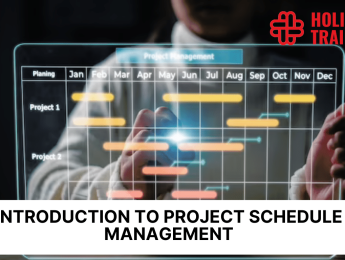- Table of Contents
- Introduction
- What Is Schedule Management?
- Why Is Having a Schedule Management Plan Important?
- Clarity and Direction
- Optimised Resource Allocation
- Risk Mitigation
- Stakeholder Alignment
- Effective Time Management
- Realistic Goal Setting
- Continuous Monitoring and Adaptation
- How to Make a Schedule Management Plan
- Step 1: Understand the Project
- Step 2: Develop a Work Breakdown Structure (WBS)
- Step 3: Identify Task Dependencies
- Step 4: Estimate Time and Resources
- Step 5: Create a Project Schedule
- Step 6: Define Milestones
- Step 7: Plan for Contingencies
- Step 8: Review and Adjust
- Ensuring the Longevity of Your Schedule Management Plan
- 1. Regular Progress Tracking
- 2. Update the Plan
- 3. Communication
- 4. Resource Management
- 5. Risk Management
- 6. Team Collaboration
- 7. Review and Learn
- Data-Driven Schedule Optimisation
- 1. Historical Data Analysis
- 2. Predictive Analytics
- 3. Task Duration Prediction
- 4. Resource Allocation Optimisation
- 5. Simulation and Scenario Analysis
- 6. Real-Time Monitoring and Adjustment
- 7. Continuous Learning and Improvement
- In Conclusion
Introduction
In the intricate world of project management, success hinges on the art of time management. Whether you're orchestrating a complex project for a client, embarking on a personal endeavour, or leading a team towards a common goal, effective schedule management is paramount. A well-crafted Schedule Management Plan serves as your compass, guiding you through the labyrinth of tasks, deadlines, and resources. In this comprehensive guide, we'll dive into the essence of Schedule Management, unravel what constitutes a robust Project Schedule Management Plan, explore the steps to craft one, and elucidate the key strategies to maintain its efficacy.
What Is Schedule Management?
At its core, Schedule Management is the process of planning, creating, and controlling a timeline for project activities. It involves delineating when tasks should be accomplished, how resources will be allocated, and how progress will be tracked. An efficient schedule helps in aligning efforts, optimising resource utilisation, and ensuring that projects are completed within the stipulated time frame. It's not just about setting dates; it's about orchestrating a symphony of tasks, dependencies, and milestones to achieve the desired outcome. Also, not every project gets the same schedule management plan; on the contrary, schedule management plans vary depending on each project’s requirements, according to the Project Manager.
Why Is Having a Schedule Management Plan Important?
In the intricate dance of project management, having a well-structured Schedule Management Plan isn't just an option – it's a necessity. The importance of such a plan cannot be overstated, as it lays the foundation for project success and ensures a harmonious symphony of tasks, resources, and time. Let's delve into the key reasons why having a Schedule Management Plan is paramount:
Clarity and Direction
A project without a clear schedule is akin to a ship without a compass, drifting aimlessly in the vast sea of tasks. A Schedule Management Plan provides the much-needed clarity and direction. It outlines the project's roadmap, delineating each task's sequence and the critical milestones. This blueprint offers a structured path that keeps everyone involved on the same page. Team members understand their roles, the order in which tasks need to be completed, and the ultimate project goals. With this clarity, confusion dissipates, detours are minimised, and the project sails smoothly towards its destination.
Optimised Resource Allocation
In the realm of project management, resources are scarce and precious commodities. Human resources, finances, equipment, and materials are finite, and their optimal utilisation is paramount. Without a Schedule Management Plan, these resources can be squandered or spread too thin, leading to inefficiencies and delays. A well-crafted plan allocates resources judiciously. It ensures that human resources are available when needed, that equipment is utilised effectively, and that financial resources are allocated to critical tasks. This optimised resource allocation not only prevents wastage but also enhances productivity, maximising the project's output within the available resources.
Risk Mitigation
Projects are not immune to uncertainties. Unexpected challenges, delays, and setbacks can emerge from various sources such as technical issues, external dependencies, or unforeseen events. A robust Schedule Management Plan acts as a safety net against these risks. By incorporating buffer time and contingency planning, the plan prepares for the unexpected. It allows project managers to anticipate potential disruptions and adjust the schedule accordingly. This proactive approach mitigates the impact of unforeseen events, ensuring that the project stays on course even in the face of unexpected challenges.
Stakeholder Alignment
Projects involve multiple stakeholders, each with their unique expectations and priorities. These stakeholders can include clients, team members, sponsors, and regulatory authorities. A well-structured Schedule Management Plan fosters transparency and alignment among these diverse stakeholders. When everyone involved understands the project's timeline, milestones, and critical deadlines, it becomes easier to manage expectations. Transparent communication facilitated by the schedule plan ensures that misunderstandings are avoided, collaborative decision-making is enabled, and conflicts are minimised. Stakeholders are engaged, informed, and confident about the project's progress, fostering a sense of trust and cooperation among all parties involved.
Effective Time Management
Time, often considered the most valuable resource, is finite and irreplaceable. Effective time management is the cornerstone of project success. A Schedule Management Plan ensures that time is allocated appropriately to tasks, preventing overruns and bottlenecks. By providing a structured timeline for each task, the plan allows project managers to monitor progress against deadlines rigorously. It enables prioritisation, ensuring that critical tasks receive the necessary attention. Effective time management not only keeps the project on track but also boosts team morale. Team members are motivated when they see progress, leading to increased productivity and a sense of accomplishment.
Realistic Goal Setting
Setting achievable and realistic goals is essential for maintaining team morale and motivation. Unrealistic expectations can lead to frustration and demotivation among team members. A Schedule Management Plan provides a realistic framework for goal setting. By accounting for task dependencies, resource availability, and potential risks, the plan ensures that the goals set are attainable. Realistic goal setting fosters a positive work environment, where team members are motivated to achieve milestones and contribute to the project's overall success.
Continuous Monitoring and Adaptation
A Schedule Management Plan is not a static document; it's a dynamic, living guide that evolves with the project. Projects are subject to change due to evolving requirements, unexpected events, or new insights. A robust Schedule Management Plan necessitates continuous monitoring and adaptation. Regular reviews of the plan allow project managers to identify deviations and address them promptly. By analysing progress against the plan and making necessary adjustments, the project remains responsive to changing circumstances. This adaptability is vital for ensuring that the project remains relevant, efficient, and aligned with the evolving needs of stakeholders.
In essence, a Schedule Management Plan is the linchpin that holds the project together. It provides the structure, clarity, and foresight necessary for successful project execution. By embracing the principles of effective scheduling and meticulously crafting a Schedule Management Plan, project managers empower their teams to navigate the complexities of project management with confidence and precision. Remember, the foundation of any successful project lies in a well-thought-out plan – a plan that serves as the guiding star in the vast expanse of project tasks, deadlines, and achievements.
How to Make a Schedule Management Plan
Crafting an effective Schedule Management Plan is akin to assembling the pieces of a puzzle – each component carefully aligned to form a comprehensive picture of the project's timeline. This process requires meticulous attention to detail, a clear understanding of project dynamics, and a strategic approach. Let's delve deeper into each step of creating a Schedule Management Plan:
Step 1: Understand the Project
Understanding the nuances of the project is fundamental to creating a successful Schedule Management Plan. Engage with key stakeholders, project sponsors, and team members to gather comprehensive insights about the project's objectives, scope, constraints, and expectations. In-depth discussions and active listening during this phase are crucial. By comprehending the big picture, project managers can make informed decisions throughout the scheduling process. Understanding the intricacies of the project lays the foundation for accurate task allocation and effective resource management.
Step 2: Develop a Work Breakdown Structure (WBS)
Creating a Work Breakdown Structure (WBS) is akin to deconstructing the project into manageable components. Think of it as dissecting a complex puzzle into smaller, comprehensible pieces. Each piece represents a specific task or activity. The hierarchical organisation of WBS provides a clear visual representation of the project's structure. It helps in breaking down the project into smaller, more manageable tasks, making it easier to assign responsibilities, track progress, and identify dependencies. The WBS serves as the backbone of the Schedule Management Plan, offering a structured framework for organising tasks and resources.
Step 3: Identify Task Dependencies
Tasks in a project rarely occur in isolation; they often rely on the completion of preceding tasks. Identifying task dependencies is akin to mapping the intricate web of relationships among tasks. There are various types of dependencies, including finish-to-start, start-to-start, finish-to-finish, and start-to-finish. Recognising these dependencies is crucial for creating a logical flow of tasks. By understanding the sequence in which tasks must be executed, project managers can prevent bottlenecks and ensure a smooth progression of activities. This step is vital for creating a realistic and feasible schedule.
Table 1: Types of task dependencies
Step 4: Estimate Time and Resources
Accurate estimation of time and resources is the cornerstone of effective scheduling. Drawing from historical data, expert opinions, and possibly even data-driven analysis, project managers assign time estimates to tasks. It involves considering the complexities of each task, the skills of team members, and potential roadblocks. Simultaneously, resource allocation is equally vital. This step involves determining the human capital, equipment, and materials required for each task. Without proper resource allocation, even the most intricately planned schedule can falter. Accurate time and resource estimation ensure that the schedule is realistic and achievable.
Step 5: Create a Project Schedule
With a clear understanding of the project, task dependencies, and resource availability, it's time to create the project schedule. Utilise project management software or scheduling tools to assemble tasks, dependencies, and resource allocation into a coherent visual representation. Gantt charts, for instance, provide a clear timeline of tasks, their durations, and dependencies. The schedule acts as a dynamic roadmap, guiding the project from initiation to completion. While creating the schedule, it's essential to factor in flexibility. Projects often encounter unforeseen changes, and the schedule should be able to accommodate these fluctuations. An adaptable schedule ensures that the project remains on track despite unexpected challenges.
Step 6: Define Milestones
Milestones are significant markers along the project's journey, signifying the completion of essential tasks or project phases. They serve as motivational signposts, providing a sense of achievement and progress. Identifying key milestones is crucial for keeping the team motivated and focused on the project's overarching goals. Milestones could represent the completion of major tasks, project phases, client reviews, or crucial deliveries. Incorporating these milestones into the schedule provides a tangible sense of progress and allows stakeholders to track the project's advancement.
Step 7: Plan for Contingencies
In the unpredictable realm of project management, preparing for contingencies is essential. Contingencies are the safety nets that prevent the project from derailing in the face of unexpected challenges. Allocate buffer time in the schedule to account for unforeseen delays or obstacles. This cushion provides room for adjustments without disrupting the entire project timeline. Additionally, develop a contingency plan that outlines specific actions to be taken in case of various risks. By having contingency measures in place, project managers can respond swiftly to unforeseen events, ensuring that the project stays on track.
Step 8: Review and Adjust
Creating a Schedule Management Plan is not a one-time activity; it's an iterative process. Regularly review the plan in collaboration with key stakeholders. Seek feedback from team members, sponsors, and clients. This collaborative approach ensures that the schedule aligns with everyone's expectations and insights. Be open to suggestions and be willing to make adjustments. As the project progresses, compare the actual progress against the planned schedule. Identify deviations, analyse their causes, and adjust the schedule accordingly. An adaptable schedule that responds to changing circumstances is a hallmark of effective Schedule Management.
By diligently following these steps, project managers can craft a Schedule Management Plan that serves as a dynamic guide throughout the project lifecycle. It empowers the team with clear directions, optimises resource utilisation, and enables the project to navigate the complexities of tasks and timelines with confidence and precision. Remember, a well-crafted Schedule Management Plan is not just a document; it's a strategic tool that ensures project success.
Ensuring the Longevity of Your Schedule Management Plan
Creating a Schedule Management Plan is just the beginning. To ensure its effectiveness throughout the project's lifecycle, continuous monitoring, adjustment, and communication are essential. Here are the key strategies to maintain a successful Schedule Management Plan:
1. Regular Progress Tracking
Continuous monitoring of the project's progress against the schedule is fundamental. Regularly track the completion status of tasks, compare them with the planned schedule, and identify any deviations or delays. Implement robust project management tools and software that offer real-time updates. By staying vigilant, project managers can promptly identify issues and take corrective actions, ensuring the project stays on course.
2. Update the Plan
As the project unfolds, it's vital to update the Schedule Management Plan to reflect the actual progress. Adjust task durations, dependencies, and milestones based on the real-time data. Be agile in responding to unexpected events and changing project dynamics. By updating the plan, project managers provide the team with a current roadmap, aligning everyone's efforts with the project's evolving needs.
3. Communication
Transparent and open communication is the lifeblood of successful project management. Keep all stakeholders informed about the project's progress and any changes to the schedule. Regular status meetings, progress reports, and updates ensure that everyone is on the same page. Transparency fosters trust among team members and stakeholders, enabling informed decision-making. Effective communication also encourages collaboration and allows for quick problem-solving, preventing minor issues from escalating into major roadblocks.
4. Resource Management
Continuously monitor resource availability and allocation. Ensure that resources are utilised efficiently and that any resource constraints are addressed promptly. If there are changes in the availability of resources, adjust the schedule accordingly. Resource management is not a one-time task; it's an ongoing process. By balancing workload and ensuring the right resources are allocated to the right tasks, project managers prevent burnout and maintain the team's productivity levels.
5. Risk Management
Stay vigilant for potential risks that could affect the schedule. Regularly assess the project's risk landscape and proactively address any identified risks. Have contingency plans in place for high-impact risks. Regular risk assessment and mitigation strategies ensure that the project is well-prepared to handle unexpected challenges. Adjust the schedule to accommodate buffer time for handling known risks and create flexibility to respond to new risks as they emerge.
6. Team Collaboration
Foster a collaborative environment where team members can communicate openly about challenges, roadblocks, and opportunities for optimisation. Encourage a culture of trust and mutual respect. Team members should feel comfortable discussing issues and proposing solutions. Collaborative problem-solving enhances creativity and often leads to innovative solutions. Regular team meetings and brainstorming sessions promote collaboration, helping the team navigate challenges effectively.
7. Review and Learn
Regularly review the Schedule Management Plan's effectiveness. Conduct post-project reviews to analyse the strengths and weaknesses of the plan. Identify areas of improvement and implement lessons learned in future projects. Learning from past experiences is invaluable for continuous improvement. Project managers should be proactive in seeking feedback from team members and stakeholders. Honest feedback reveals areas that need adjustment and helps refine the approach for future projects.
In summary, a Schedule Management Plan is not a static document; it's a dynamic tool that evolves with the project. By continuously monitoring progress, updating the plan, fostering open communication, managing resources effectively, addressing risks, promoting collaboration, and learning from experiences, project managers can ensure the longevity and effectiveness of their Schedule Management Plan. Embracing these strategies empowers project managers to navigate the complexities of project execution successfully and deliver exceptional results. Remember, a well-maintained Schedule Management Plan is the linchpin that sustains project momentum and ensures a smooth journey from initiation to completion.
Data-Driven Schedule Optimisation
In the contemporary landscape of project management, data-driven approaches have become instrumental in ensuring project success. By harnessing the power of data analytics and insights, project managers can optimise schedules, predict bottlenecks, and enhance overall project efficiency. Let’s find out the key components and benefits of data-driven schedule optimisation:
1. Historical Data Analysis
One of the fundamental aspects of data-driven schedule optimisation is the analysis of historical project data. By delving into past projects, project managers can identify patterns, trends, and common challenges. Analysing historical data provides valuable insights into task durations, resource utilisation, and potential obstacles faced in similar projects. These insights serve as a foundation for creating realistic schedules, allowing project managers to set accurate expectations and allocate resources effectively.
2. Predictive Analytics
Predictive analytics leverage historical data and advanced algorithms to forecast future project outcomes. By employing predictive models, project managers can anticipate potential project bottlenecks, resource constraints, and task dependencies. Predictive analytics enable the identification of potential risks before they escalate, allowing for proactive mitigation strategies. By foreseeing challenges, project managers can adjust schedules in advance, ensuring the project stays on track and minimising the impact of unforeseen events.
3. Task Duration Prediction
Data-driven tools can analyse historical task durations, considering various factors such as complexity, resource expertise, and task dependencies. These analyses generate accurate predictions for similar tasks in future projects. By having precise estimates for task durations, project managers can create schedules that reflect the project's true timeline. This accuracy prevents overestimation or underestimation of task durations, leading to a more realistic and achievable project schedule.
4. Resource Allocation Optimisation
Data-driven insights enable optimised resource allocation. By analysing historical resource utilisation patterns, project managers can identify peak productivity periods, resource bottlenecks, and underutilised capacities. Utilising this information, project managers can allocate resources effectively, ensuring that tasks are assigned to team members during their most productive hours. Optimised resource allocation prevents burnout, enhances efficiency, and ensures that tasks are completed within the allocated timeframes.
5. Simulation and Scenario Analysis
Advanced project management software allows project managers to simulate different project scenarios. By tweaking variables such as task sequences, resource allocation, and dependencies, project managers can assess the impact of various scenarios on the project schedule. This simulation approach enables project managers to choose the most optimised schedule that aligns with the project's goals. By running multiple scenarios, project managers can make data-driven decisions, selecting the schedule that offers the highest efficiency and likelihood of success.
Table 2: The evolution of project scheduling tools
Decade | Project Scheduling Tools |
1980s | Manual Gantt charts and spreadsheets |
1990s | Introduction of Microsoft Project, enhancing visual representation of schedules |
2000s | Web-based project management software, enabling collaborative scheduling and real-time updates |
2010s | Integration of artificial intelligence, machine learning, and data analytics for predictive and optimised scheduling |
2020s | Emergence of blockchain technology for secure, transparent, and tamper-proof project scheduling |
6. Real-Time Monitoring and Adjustment
Data-driven tools provide real-time monitoring capabilities. Project managers can track project progress against the planned schedule, identifying deviations as soon as they occur. Real-time monitoring allows for immediate corrective actions, ensuring that the project stays on track. Additionally, data-driven insights enable agile adjustments to the schedule based on real-time data. If unexpected events occur, project managers can swiftly adapt the schedule, making informed decisions supported by real-time data analysis.
7. Continuous Learning and Improvement
Data-driven schedule optimisation facilitates a culture of continuous learning within the project team. By analysing the outcomes of schedule adjustments and project decisions, project managers can gain insights into what works best for specific project contexts. These insights can be applied to future projects, enhancing the organisation's overall project management strategies. Continuous learning from data-driven analyses leads to the refinement of scheduling techniques, ensuring that each subsequent project benefits from the knowledge gained from past experiences.
In short, data-driven schedule optimisation revolutionises the way projects are managed. By harnessing the power of historical data, predictive analytics, precise task duration predictions, optimised resource allocation, simulation, real-time monitoring, and continuous learning, project managers can create schedules that are not only realistic but also highly efficient. Embracing data-driven approaches empowers project managers to navigate the complexities of project management with confidence, ensuring that projects are completed on time, within scope, and with optimal resource utilisation. Remember, in the data-driven era, informed decisions backed by accurate insights are the key to unlocking project management excellence.
In Conclusion
A well-crafted Schedule Management Plan is the cornerstone of successful project execution. It not only guides your efforts but also ensures that projects are completed on time, within scope, and with optimal resource utilisation. By understanding the principles of Schedule Management, creating a comprehensive Project Schedule Management Plan, and diligently maintaining it, you'll set yourself up for project management excellence. Remember, the art of time management is a journey, and an effective schedule is your guiding light through the complex landscape of tasks, deadlines, and achievements.
If you're eager to dive deeper into the art of effective task and time management, make sure to check out our course, ‘Essential Planning & Scheduling Skills for Successful Project Management,’ where you'll gain practical insights and strategies to master the art of orchestrating tasks within a tight timeline. Your journey to project excellence starts here!

























